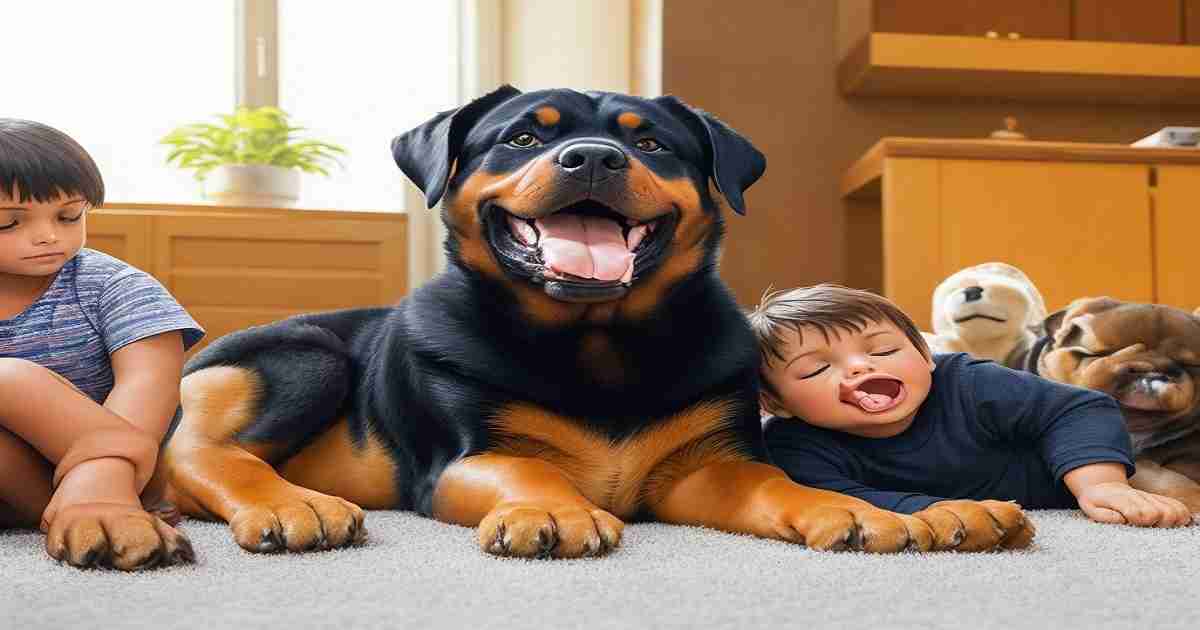The Rottweiler is one of the most recognizable and iconic dog breeds in the world. Rottweilers have gained popularity as family pets, guard dogs, police dogs, and guide dogs thanks to their robust, powerful build and obedient nature.
This page thoroughly summarises the background, traits, and appeal of this extraordinary breed.
With their distinctive black coats and rich tan markings, Rottweilers are impressive-looking dogs that command attention wherever they go.
They are medium to large, muscular, athletic, and confident and intelligent. While some people may find their appearance intimidating, owners often describe Rottweilers as gentle giants who are deeply devoted to their families.
Rottweilers, bred initially as cattle herding and guarding dogs in Germany, have a long history of working roles.
Today, they thrive as police, military and service dogs, in competitive dog sports, as therapy animals, and most commonly as beloved pets.
When properly trained and socialized, Rottweilers make excellent guardians and companions for the right owners.
Historical Origins of the Rottweiler Breed
The Rottweiler descends from ancient Roman drover dogs that accompanied Roman legions on long marches across Europe.
Their job was to herd cattle to feed the soldiers along the way. Shortly after the Roman conquest, local dogs in the German town of Rottweil continued this legacy, driving and protecting cattle that fed the growing community.
The descendants of these Roman dogs became known as the Rottweil Metzgerhund, named for the butchers of Rottweil who used them to herd cattle to market.
Their robust size and strength allowed them to control large, stubborn herds. By the mid-19th century, railways had made cattle driving obsolete, and the breed began to be used more for draught work and as guard dogs.
1901, the Rottweiler Klub was formed in Germany to preserve and promote the breed. The name was then officially changed to “Rottweiler”.
The American Kennel Club formally recognized the Rottweiler in 1931 after the breed attained widespread acclaim in the late 1920s.
Key Characteristics and Physical Appearance
The Rottweiler is a muscular, powerful, and athletic-looking medium to large-sized dog.
Some key characteristics include:
Size: Males typically stand 24-27 inches tall at the shoulder; females 22-25 inches. They generally weigh 80-135 pounds.
Coat: Short, dense, and coarse outer coat with softer undercoat.
Colouring: Distinctive black coat with rich tan markings on the cheeks, muzzle, chest, legs, and feet.
Head: Broad, slightly domed skull and powerful muzzle.
Eyes: Almond-shaped, medium size, dark brown in colour.
Ears: Triangular, small to medium, and pendant-shaped, hanging close to the head.
Tail: Docked short in some countries; left long and extending to the hock in others. Carried horizontally.
There are some variations in size with the Rottweiler, mainly:
Standard: Conforms to the breed standards stated above.
Miniature: Significantly smaller in size, usually produced by selective breeding. Not recognized by major kennel clubs.
Temperament and Behavior of Rottweiler Breed
Rottweilers are steady, confident, and self-assured dogs. They are even-tempered and fond of their families.
With proper socialization and training from an early age, Rottweilers can be trusted guardians around children and strangers.
However, they have strong territorial instincts tied to their history as guard dogs. They demand knowledgeable owners to control their guarding inclinations and considerable obedience training.
Early exposure to various people and animals reduces the likelihood of overprotective behaviour.
Rottweilers flourish under strict direction and mental challenge.
They are intelligent and respond best to positive reinforcement training and consistency. Owners need to establish rules and boundaries early on.
With the proper upbringing and training, Rottweilers are calm, obedient companions.
Myths about aggression: Unfortunately, Rottweilers have a reputation for attack due to irresponsible ownership, breeding, and training.
However, any dog can be aggressive regardless of breed. Proper training and socialization greatly minimize the risks. Rottweilers who come from reputable breeders and receive the appropriate care do not inherently have behavioural issues.
Rottweilers as Family Pets
The Rottweiler is a great family pet because of its devotion.
They thrive when included as part of the family and respond very well to training, consistency, and encouragement from all family members, including children.
Rottweilers should be supervised around very young children simply due to their large size.
But most Rottweilers enjoy playing gently with older children, and protective instincts also extend to kids.
With early exposure to children and proper training, Rottweilers live happily alongside families.
However, they have energetic exercise needs, so families must commit to providing adequate outdoor time and play.
Rottweilers also require structured obedience training starting as puppies, so owners should be prepared to invest time in formal training classes throughout their lives. Rottweilers form devoted and devoted family dogs with the correct owners.
Training and Obedience
Rottweilers are working dogs that thrive when given direction and structure. They are typically simple to teach because of their high level of intelligence and desire to please their owners.
Here are some essential training needs and tips:
Obedience training: Formal training should begin early and continue through adulthood. Rottweilers must learn basic cues like sit, stay, come, down, and heel.
Socialization: Extensive exposure to new people, animals, places, and experiences from a young age is crucial. Well-socialized Rottweilers are friendly and confident.
Positive reinforcement: This breed responds exceptionally well to reinforcement training and food rewards.
Consistency: Firm, fair training is essential. All family members should uphold rules and commands.
In addition to basic obedience and social skills, Rottweilers often excel at various specialized training roles, including:
- Agility and competitive dog sports
- Search and rescue
- Service and therapy work
- Police, military, and guard dog roles
Their intelligence, athleticism and aim to please make Rottweilers competent working dogs when given proper training outlets.
Health and Common Health Issues
Rottweilers are generally a robust, healthy breed with an average lifespan of 9-10 years. However, like all breeds, they are prone to certain health conditions that owners should be aware of:
Hip and elbow dysplasia: Malformation of these joints is common in larger breeds. It can lead to osteoarthritis if not managed.
Cardiac conditions: Subaortic stenosis, cardiomyopathy. It can cause fainting, lethargy, and shortness of breath.
Cancer: Unfortunately, bone, lymphoma and other cancers occur at higher-than-average rates.
Bloat: A twisted stomach is a life-threatening emergency common in deep-chested dogs. Prevent through proper feeding and exercise.
To maximize health and longevity, owners should focus on:
- Providing regular exercise and maintaining a healthy weight
- Feeding a complete and balanced diet
- Annual vet exams and screening for genetic conditions
- Prompt veterinary care if any symptoms arise
Rottweilers can enjoy active lives well into their senior years with proper care and regular health checks.
Grooming and Coat Care
Rottweilers have low maintenance grooming needs overall thanks to their short, dense coat:
Brushing: It only requires occasional brushing to remove dead hair. More frequent during seasonal shedding periods.
Bathing: Only bathe when truly dirty. Over-bathing can strip the coat of natural oils.
Nails: Trim regularly to avoid cracking or overgrowth. This is especially important if not walking on hard surfaces.
Ears: Check and wipe ears weekly to prevent infections.
Teeth: Daily tooth brushing is ideal. If not possible, provide chew toys and dental treats to reduce plaque.
Their grooming routine is easy to maintain at home with the proper schedule. Be sure to make grooming a positive experience with rewards to set them up for success in handling and brushing from a young age.
Exercise Requirements
Rottweilers have high exercise needs. They may become restless or engage in destructive behavior without sufficient daily activity. Plan to provide:
Daily walks: A minimum of 30–60 minutes per day of brisk walking on a leash. More for younger dogs.
Playtime: Active play like fetching, tug of war, catching a ball/frisbee. Use mentally stimulating toys.
Backyard time: Safely monitored outdoor time for exploring and running around. Ensure the fencing is secure.
Mental exercise: Besides physical activity, provide puzzle toys and training sessions to engage their minds.
Variety: Switch up types of exercise daily to prevent boredom. Take them on outings, like hikes.
Keeping Rottweilers well exercised will satisfy their high energy needs and prevent problem behaviors. Ensure that you stimulate your body and mind.
Rottweilers in Different Positions
Rottweilers are excellent working, sporting, service, and companion dogs.
Some examples include:
Police and guard dogs: Their intelligence and protective nature make them excel at suspect apprehension, public order control, and property security.
Search and rescue dogs: Rottweilers are used to locate missing people due to their tracking abilities and focused work ethic.
Military dogs: Used historically and currently for patrolling, guarding, and other defence applications by military and private security firms.
Service dogs: Well suited for guide work and mobility assistance due to their trainability and calm temperament on duty.
Competitive sports: Rottweilers compete successfully in obedience trials, agility courses, weight pulls, and Schutzhund protection sports.
Therapy animals: Their affectionate nature allows them to provide comfort and stress relief in hospitals, schools, and nursing homes.
Because of their adaptability, power, and intelligence, Rottweilers can still play vital roles in homes.
Popularity and Acceptance
The Rottweiler is consistently in demand worldwide as a working dog and companion breed. Here are some crucial details regarding their prevalence:
The American Kennel Club ranks Rottweilers as the eighth most popular breed in the country.
They have consistently ranked highly among the top 10 breeds, which speaks to their adaptability.
The Fédération Cynologique Internationale ranks them as the 9th most popular breed internationally.
Rottweilers have won “Best in Show” awards at prestigious events like the Westminster and Crufts dog shows.
They compete successfully in Schutzhund protection sports trials and increasingly in agility.
Rottweilers are recognized by all major kennel clubs and have dedicated breed clubs in most developed nations.
The breeds’ enduring popularity results from their adaptability, intelligence, and loyalty to their masters when appropriately trained.
Responsible Ownership
Although they can be fantastic companions, Rottweilers need devoted owners willing to devote much time and effort to their upbringing.
Key considerations include:
Breeder selection: Seek reputable breeders who health screen breeding dogs. Avoid backyard breeders or puppy mills.
Training commitment: Invest substantial time and money into professional training classes starting as a puppy.
Exercise needs: Rottweilers need over an hour of intensive daily routine and mental stimulation.
Supervision: They should be supervised around children and controlled in public areas.
Socialization: Extensive socialization to people, animals and environments is essential.
Legal restrictions: Some housing communities or insurance policies prohibit Rottweilers, so check regulations first.
When given the proper care, training, and attention, Rottweilers will thrive and give owners years of devoted service.
Frequently Asked Questions
Are Rottweilers good with children and other pets?
- Most Rottweilers do very well with children and other household pets with proper introduction and supervision. Their protective instincts can make them excellent companions for kids. Early socialization is critical.
Do Rottweilers require a lot of exercise?
- Yes, Rottweilers have very high exercise needs – at least an hour per day of rigorous activity. They thrive when given jobs or sports to expend their energy.
How do I socialize my Rottweiler effectively?
- Introduce them to various people, dogs, places, sounds and experiences starting as a puppy. Use positive reinforcement to build their confidence. Sign up for formal training classes that include socialization.
What are the common misconceptions about their temperament?
- Many people wrongly assume Rottweilers are inherently aggressive. With proper training and care, Rottweilers exhibit steadfast loyalty and calm demeanours. Their reputation stems from irresponsible owners.
Can Rottweilers live in apartments?
- While challenging, Rottweilers can adapt to apartment living given enough daily exercise and stimulation. Access to a dog park is ideal. Apartments with breed restrictions may prohibit Rottweilers.
How should I groom my Rottweiler’s coat?
- Rottweilers need only occasional brushing and bathing. Trim nails regularly, clean ears weekly and brush teeth daily. Their short coat is easy to groom at home. Shedding is moderate.
What health issues should I watch out for?
- Owners should be aware of potential joint problems, heart conditions, cancer and bloat. Vet exams, screening, and preventative care help minimize risks. Overall, Rottweilers are a robust, healthy breed.
Are Rottweilers easy to train?
- Yes, Rottweilers are highly intelligent and aim to please. They respond very well to positive reinforcement training and food motivation. However, training must be consistent across all family members.
What is their typical lifespan?
- The average lifespan of a Rottweiler is 9-10 years. Some may live longer with diligent health screening and preventative veterinary care.
Are Rottweilers prone to aggressive behaviour?
- Aggression in Rottweilers almost always results from lack of training, socialization, neglect or irresponsible ownership. Well-bred, properly raised Rottweilers exhibit steady, calm demeanours.
Conclusion
With origins as rugged cattle herding dogs, Rottweilers maintain their versatility and strengths as guardians, police dogs, and cherished family pets.
Their intelligence, confidence and devotion shine through when given proper care, training, and outlet for their considerable abilities.
Rottweilers require dedicated ownership but repay that investment with years of loyalty and service.
They are imposing yet affectionate dogs that thrive when working closely in tandem with their owners.









2 thoughts on “Rottweiler Breed Overview – History, Characteristics, and Popularity”